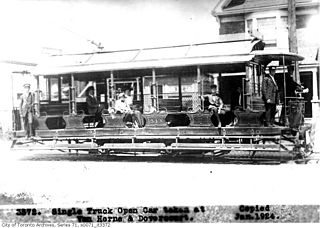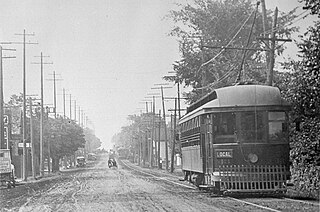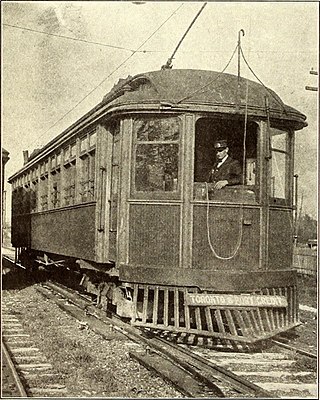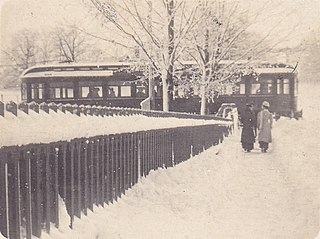
Burlington is a city in the Regional Municipality of Halton at the west end of Lake Ontario in Ontario, Canada. Located approximately halfway between Toronto and Niagara Falls, it is part of the Greater Toronto and Hamilton Area and Hamilton metropolitan census area.

The Hamilton Street Railway commonly known as the HSR is a public transport agency in Hamilton, Ontario, Canada. The name is a legacy of the company's early period, when public transit in Hamilton was primarily served by streetcars. Although streetcars are no longer used in the city today, the HSR operates bus and paratransit services, with a ridership of 21 million passengers a year. The HSR uses the Presto card as its method of fare payment, allowing for connections with GO Transit and other transit systems in the Greater Toronto area.

The Toronto Railway Company (TRC) was the operator of the streetcar system in Toronto between 1891 and 1921. It electrified the horsecar system it inherited from the Toronto Street Railway, the previous operator of streetcar service in Toronto. The TRC was also a manufacturer of streetcars and rail work vehicles, a few of which were built for other streetcar and radial operators.
The Toronto Suburban Railway was a Canadian electric railway operator with local routes in west Toronto, and a radial (interurban) route to Guelph.

Toronto Civic Railways (TCR) was a streetcar operator created and owned by the City of Toronto, Ontario, Canada, to serve newly annexed areas of the city that the private operator Toronto Railway Company refused to serve. When the Toronto Railway Company's franchise expired in 1921, its services were combined with those of the Toronto Civic Railways, and are now assumed by the new Toronto Transportation Commission (TTC). The first route of the TCR started operation on December 18, 1912.

The Metropolitan line in the Toronto area, operated by the Metropolitan Street Railway, started out as a local horsecar line and transformed itself into an electric radial line extending to Lake Simcoe, following an old stage coach route. In 1904, the railway was acquired by the Toronto and York Radial Railway (T&YRR) and became the T&YRR Metropolitan Division. In 1922, the City of Toronto acquired the T&YRR and contracted Ontario Hydro to manage the four T&YRR lines including the Metropolitan. In 1927, the TTC took over the operation of the Metropolitan Line to Sutton, and renamed it the Lake Simcoe line. In 1930, the TTC closed the Metropolitan Line but shortly reopened the portion between Glen Echo and Richmond Hill operating it as the North Yonge Railways until 1948.

The North Yonge Railways was a radial railway line operated by the Toronto Transportation Commission from 1930 to 1948 between Glen Echo (Toronto) and Richmond Hill. The line was created by reopening the southern portion of the TTC's Lake Simcoe radial line that had closed in 1930.

Bayview Junction is a major railway junction in southern Ontario, Canada. It is located at the intersection of three of the nation's busiest rail lines and is a popular location for railfans and trainspotters.

Toronto and Scarboro' Electric Railway, Light and Power Company was established in August 1892 to provide street railway service to the Upper Beaches district within the City of Toronto, Ontario and to the neighbouring Township of Scarborough. Except for two branches, the line ran as a radial along Kingston Road.

The Toronto and Mimico Electric Railway and Light Company was incorporated in 1890, and operated the Mimico radial line in the Toronto area. The line started operation in 1892 as a short suburban line that later was extended to Port Credit. In 1904, the railway was acquired by the Toronto and York Radial Railway (T&YRR) and became the T&YRR Mimico Division. In 1922, the City of Toronto acquired the T&YRR and contracted Ontario Hydro to manage the four T&YRR lines including the Mimico line. In 1927, the TTC took over the operation of the Mimico line and extended its service eastward to Roncesvalles Avenue. In 1928, the TTC double-tracked the line from Humber to Long Branch and made that portion part of the Lake Shore streetcar line. The portion beyond Long Branch to Port Credit became the Port Credit line, and continued operation as a single-track radial line until its closure on February 9, 1935.
The Hamilton and Dundas Street Railway was an interurban railway operator which ran between Hamilton and Dundas in Southern Ontario, Canada.
The Hamilton, Grimsby and Beamsville Electric Railway (HG&B) was an interurban railway that operated between Hamilton and Vineland in the Niagara Peninsula in Ontario, Canada. It was incorporated in 1894.

The Brantford and Hamilton Electric Railway (B&H) was an interurban electric railway which operated between Hamilton and Brantford in Ontario, Canada. According to Hilton & Due, this was the last radial (interurban) railway constructed in the Hamilton area and the only one built to a high standard.

Beach Boulevard is a Lower city street in Hamilton, Ontario, Canada, east of the Hamilton Harbour on a thin piece of land that crosses over Lake Ontario and stretches from where Woodward Avenue becomes Eastport Drive in the south to near the Lift Bridge in the north at Eastport Drive (again). It runs parallel with the QEW and the Burlington Bay James N. Allan Skyway Bridge.

The Roncesvalles Carhouse is a storage and maintenance facility for the streetcar network of the Toronto Transit Commission. Located at the northwest corner of the Queensway and Roncesvalles Avenue in Toronto, Ontario, west of its downtown core, it is the oldest of the TTC's three active carhouses. The carhouse serves vehicles on routes 501 Queen, 504 King, 505 Dundas, 506 Carlton, 511 Bathurst, and 512 St. Clair.

The New London and East Lyme Street Railway was a streetcar line that operated in southeastern Connecticut. Its main line ran from New London to Niantic with a later extension to Crescent Beach and a branch to Old Saybrook. The main portion of the line opened on October 5, 1905. The line was extended to Crescent Beach in 1912. In 1913, it was acquired by the Shore Line Electric Railway and extended to Old Lyme.

Beginning operation in 1861, the Yonge streetcar line was the first streetcar line in Toronto and the first in Canada. It started off as a horsecar line and closed in 1954 operating two-unit trains of Peter Witt motors pulling a trailer. Under the Toronto Transportation Commission, the Yonge line was the busiest and most congested streetcar line in the city leading to its replacement in 1954 by the Yonge Subway line, also Toronto's first and the first in Canada.
The Hamilton and North-Western Railway (H&NW) is a former railway in Ontario, Canada. It ran north from Hamilton on the western end of Lake Ontario to Collingwood on Georgian Bay and Barrie on Lake Simcoe. Through the purchase of the Hamilton and Lake Erie Railway, the route continued south from Hamilton to Port Dover on Lake Erie.

Lakeshore Road is a historic roadway in the Canadian province of Ontario, running through the city of Burlington and the town of Oakville in Halton Region, as well as the city of Mississauga in Peel Region. As its name implies, the road closely follows the shoreline of Lake Ontario, although the lake itself is not visible from the road in most areas. Lakeshore Road was once a key section of the historic Highway 2, which traversed the province, but has since been downloaded to local municipalities. Despite this historical role as a major route, however, most of the road is a lower-capacity picturesque residential and historic commercial street with only two through lanes until it becomes a four-lane, higher-volume artery after it enters Mississauga and jogs to the north.

Toronto-gauge railways are tram and rapid transit lines built to Toronto gauge, a broad gauge of 4 ft 10+7⁄8 in. This is 2+3⁄8 in (60 mm) wider than standard gauge of 4 ft 8+1⁄2 in which is by far the most common track gauge in Canada. The gauge is unique to the Greater Toronto Area and is currently used on the Toronto streetcar system and the Toronto subway, both operated by the Toronto Transit Commission. As well, the Halton County Radial Railway, a transport museum, uses the Toronto gauge so its rail line can accommodate its collection of Toronto streetcars and subway trains. Several now-defunct interurban rail systems also once used this gauge.



















